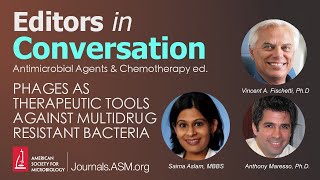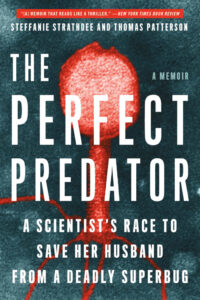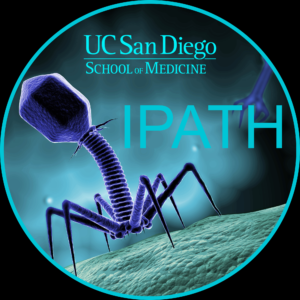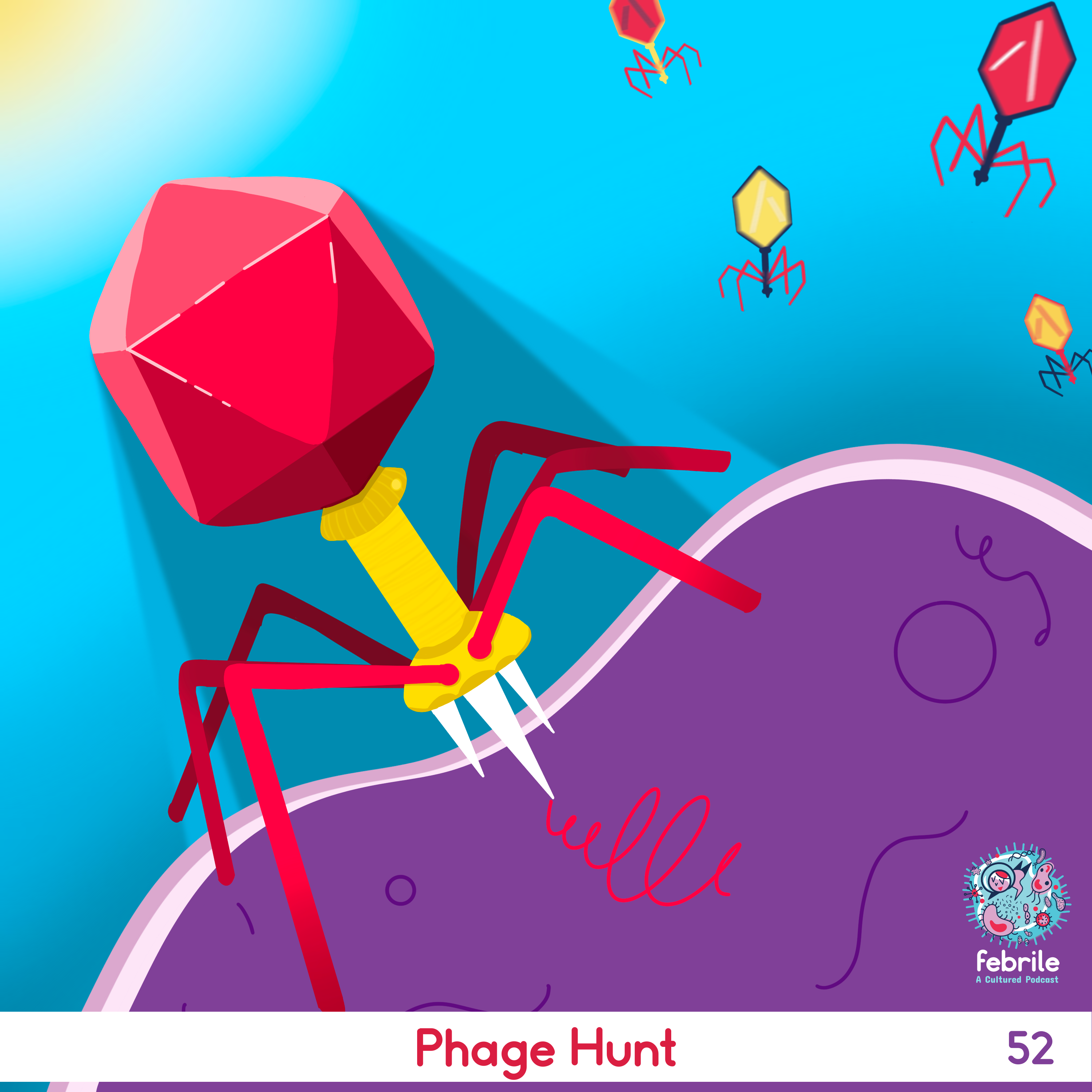Table of Contents
Credits
Host: Sara Dong
Guest: Saima Aslam
Writing/Producing/Editing/Cover Art: Sara Dong
Our Guests
Saima Aslam, MBBS

Dr. Aslam is a Professor of Medicine at the Division of Infectious Diseases and Global Public Health at the University of California San Diego (UCSD). She is a transplant infectious diseases physician and is the Director of the Solid Organ Transplant Infectious Diseases service at UCSD. She has been engaged in phage therapy since 2017 and is the Clinical Lead at the Center for Innovative Phage Applications and Therapeutics (IPATH) at UCSD.
Dr Aslam currently has funding through the Cystic Fibrosis Foundation for a pilot study to develop a clinical registry of Burkholderia infected patients with CF and develop an associated bacteriophage library. She is also co-investigator in a U01 grant from NIH/ NIAID to combat multi-drug resistance through innovative applications, including phage therapy. Dr. Aslam is involved in multiple transplant-related clinical trials as well as an ongoing study investigating the use of phage-lysin for Staphylococcus aureus bacteremia.
Culture
Saima shared some recent bonding with family and friends with henna during Eid!
Consult Notes
Consult Q
Lung transplant recipient with multidrug resistant Pseudomonas – can we use phage therapy?
Case Summary
55 year old female with a history of cystic fibrosis s/p bilateral lung transplant and chronic colonization with MDR Pseudomonas aeruginosa who was treated with IV and nebulized bacteriophage therapy
Key Points
Introduction to bacteriophages / phage therapy
- Bacteriophages = viruses that bind to bacterial surface receptors and get internalized within the bacterial cell >> transfer their viral DNA/RNA into the host >> produce virions that lyse bacterial cell >> phage progeny then infect other bacterial cells
- Most phages are specific to one or a few strains of bacteria
- Phages do not infect eukaryotic cells, which reduces adverse events (large differences between bacterial prokaryotic and human eukaryotic cells prevent cross-infection)
- Bacteriophage therapy involves identifying and administering phages to target specific pathogenic bacteria, and the limited antibiotic options for MDR bacteria and mycobacteria + technical advances in phage purification have led to renewed clinical interest/use
- Phages were initially discovered in the pre-antibiotic era, and there have been phage preparations used for GI and upper respiratory illnesses! There is little published information about these uses, so the effectiveness is unknown
What types of infections can we use phage therapy for?
- There have been a variety of bacterial infections that phage therapy has been used for. It is not used for fungal/viral/parasitic infections
- If you want to start with one paper, I’d recommend this one! It’s from our guest and focuses on their experience with IV phage therapy: Aslam S, Lampley E, Wooten D, et al. Lessons Learned From the First 10 Consecutive Cases of Intravenous Bacteriophage Therapy to Treat Multidrug-Resistant Bacterial Infections at a Single Center in the United States. Open Forum Infect Dis. 2020;7(9):ofaa389. Published 2020 Aug 27. doi:10.1093/ofid/ofaa389
- Some important case reports / papers below:
- Staph:
- Mu A, McDonald D, Jarmusch AK, et al. Assessment of the microbiome during bacteriophage therapy in combination with systemic antibiotics to treat a case of staphylococcal device infection. Microbiome. 2021;9(1):92. Published 2021 Apr 14. doi:10.1186/s40168-021-01026-9
- Petrovic Fabijan A, Lin RCY, Ho J, et al. Safety of bacteriophage therapy in severe Staphylococcus aureus infection [published correction appears in Nat Microbiol. 2020 Apr;5(4):652]. Nat Microbiol. 2020;5(3):465-472. doi:10.1038/s41564-019-0634-z
- Acinetobacter baumanii: Schooley RT, Biswas B, Gill JJ, et al. Development and Use of Personalized Bacteriophage-Based Therapeutic Cocktails To Treat a Patient with a Disseminated Resistant Acinetobacter baumannii Infection [published correction appears in Antimicrob Agents Chemother. 2018 Nov 26;62(12):]. Antimicrob Agents Chemother. 2017;61(10):e00954-17. Published 2017 Sep 22. doi:10.1128/AAC.00954-17
- Pseudomonas aeruginosa: Duplessis C, Biswas B, Hanisch B, et al. Refractory Pseudomonas Bacteremia in a 2-Year-Old Sterilized by Bacteriophage Therapy. J Pediatric Infect Dis Soc. 2018;7(3):253-256. doi:10.1093/jpids/pix056
- M.abscessus (first clinical use of mycobacterial phage and first clinical use of genetically engineered phage): Dedrick RM, Guerrero-Bustamante CA, Garlena RA, et al. Engineered bacteriophages for treatment of a patient with a disseminated drug-resistant Mycobacterium abscessus. Nat Med. 2019;25(5):730-733. doi:10.1038/s41591-019-0437-z
- Dedrick RM, Smith BE, Cristinziano M, et al. Phage Therapy of Mycobacterium Infections: Compassionate-use of Phages in Twenty Patients with Drug-Resistant Mycobacterial Disease [published online ahead of print, 2022 Jun 9]. Clin Infect Dis. 2022;ciac453. doi:10.1093/cid/ciac453
- MDR P.aeruginosa in CF patient that went onto transplant: Law N, Logan C, Yung G, et al. Successful adjunctive use of bacteriophage therapy for treatment of multidrug-resistant Pseudomonas aeruginosa infection in a cystic fibrosis patient. Infection. 2019;47(4):665-668. doi:10.1007/s15010-019-01319-0
- Kutter E, De Vos D, Gvasalia G, et al. Phage therapy in clinical practice: treatment of human infections. Curr Pharm Biotechnol. 2010;11(1):69-86. doi:10.2174/138920110790725401
- Bone & joint: Gibb BP, Hadjiargyrou M. Bacteriophage therapy for bone and joint infections. Bone Joint J. 2021;103-B(2):234-244. doi:10.1302/0301-620X.103B2.BJJ-2020-0452.R2
- Staph:
- We used a transplant recipient as the example case in this episode. Some bacteriophage experience specifically in transplant or ventricular assist device (VAD) recipients are noted below
- Podcast case loosely created from the example patients in this series. Features 3 cases from UCSD, UPenn, Cleveland Clinic: Aslam S, Courtwright AM, Koval C, et al. Early clinical experience of bacteriophage therapy in 3 lung transplant recipients. Am J Transplant. 2019;19(9):2631-2639. doi:10.1111/ajt.15503
- Kidney transplant recipient with recurrent UTIs and epididymitis due to ESBL-Klebsiella pneumoniae: Kuipers S, Ruth MM, Mientjes M, de Sévaux RGL, van Ingen J. A Dutch Case Report of Successful Treatment of Chronic Relapsing Urinary Tract Infection with Bacteriophages in a Renal Transplant Patient. Antimicrob Agents Chemother. 2019;64(1):e01281-19. Published 2019 Dec 20. doi:10.1128/AAC.01281-19
- VAD infection:
- Aslam S, Pretorius V, Lehman SM, Morales S, Schooley RT. Novel bacteriophage therapy for treatment of left ventricular assist device infection. J Heart Lung Transplant. 2019;38(4):475-476. doi:10.1016/j.healun.2019.01.001s
- Tkhilaishvili T, Potapov E, Starck C, et al. Bacteriophage therapy as a treatment option for complex cardiovascular implant infection: The German Heart Center Berlin experience [published online ahead of print, 2022 Jan 26]. J Heart Lung Transplant. 2022;S1053-2498(22)00036-5. doi:10.1016/j.healun.2022.01.018
- VRE in pediatric liver transplant recipient: Paul K, Merabishvili M, Hazan R, et al. Bacteriophage Rescue Therapy of a Vancomycin-Resistant Enterococcus faecium Infection in a One-Year-Old Child following a Third Liver Transplantation. Viruses. 2021;13(9):1785. Published 2021 Sep 7. doi:10.3390/v13091785
What are the steps and timeframe for undergoing the process of assessing patients for phage therapy?
- Some great overview articles to start for learners:
- Aslam S. Bacteriophage therapy as a treatment option for transplant infections. Curr Opin Infect Dis. 2020;33(4):298-303. doi:10.1097/QCO.0000000000000658
- Suh GA, Lodise TP, Tamma PD, et al. Considerations for the Use of Phage Therapy in Clinical Practice [published online ahead of print, 2022 Jan 18]. Antimicrob Agents Chemother. 2022;AAC0207121. doi:10.1128/AAC.02071-21
- Cui Z, Guo X, Feng T, Li L. Exploring the whole standard operating procedure for phage therapy in clinical practice. J Transl Med. 2019;17(1):373. Published 2019 Nov 14. doi:10.1186/s12967-019-2120-z
- Phage therapy is experimental and not FDA approved >> requires approval under single-use EIND application, which is based on demonstration of in-vitro lytic activity of phage(s) against the patient’s pathogen, genetic characterization of phage with demonstrated lack of antibiotic resistance genes, lack of lysogenic potential, sterility of final product, minimal endotoxin concentration
- Step one is to consider this therapy for your patient and make sure that their clinical isolates are saved by the Micro Lab
- It takes a few weeks to several months to be available for clinical use!
- Two main approaches of phage therapy:
- Personalized phage therapy: compare patient’s bacterial isolate against phage library to choose the most active phages
- Fixed phage combination: develop an off-the-shelf product with fixed combination of phages active against broad range of bacterial strains within bacterial spp
- Genetically modified phages can be explored as off the shelf project
How is bacteriophage susceptibility determined?
There are two commonly used methods for susceptibility testing:
- Double agar overlay plaque assay: bacterial lawns on agar plate > assess clear plaques with successive dilutions of phage
- Biolog method: measures color change when various phage dilutions are combined with a standard bacterial suspension
As Saima mentioned, there can be incongruity between these two methods, and we don’t know which is the better test. There is ongoing investigation to understand susceptibility testing and how that translates to their clinical response.
Phage cocktails (combinations of phages) are sometimes used due to concern for the risk of resistance to single phage. What causes resistance to phages?
- Usually you want to use a combination of phages (phage cocktail) that have different receptors for attaching to a certain organism >> so if the bacteria does develop resistance, there would be other phages that can still kill the bacteria
- Development of phage resistance doesn’t always occur, as Saima discussed. We’re still trying to understand whether its a particular phage and bacterial interaction that is more susceptible to resistance?
What are some of the challenges and unanswered questions that remain?
- Optimal dosing concentration, interval, route of administration (are certain routes preferred for certain infections? need for PK/PD studies)
- Ability to mass manufacture
- Storage stability
- Understanding susceptibility and resistance testing
- Role of immune response
- Will we eventually be able to use phage alone without antibiotics? Or is there a synergistic combination?
Check out these additional items mentioned from the show

Check out Saima Aslam on the podcast ASM Editors in Conversation: Phages as Therapeutic Tools Against Multidrug Resistant Bacteria

The Perfect Predator: A Scientist’s Race to Save Her Husband from a Deadly Superbug by Steffanie Strathdee & Thomas Patterson

You can view the UC San Diego Center for Innovative Phage Applications and Therapeutics (iPATH) in the Division of Infectious Diseases & Global Public Health here
Here is the direct link to the Patient Stories that Saima mentioned
Infographics
Goal
Listeners will be able to understand the role of bacteriophages as an investigational tool against multidrug resistant bacterial infection
Learning Objectives
After listening to this episode, listeners will be able to:
- Describe how a bacteriophage can lead to bacterial cell lysis
- Discuss clinical scenarios that might benefit from bacteriophage therapy
Disclosures
Our guest (Saima Aslam) as well as Febrile podcast and hosts report no relevant financial disclosures
Citation
Aslam, S., Dong, S. “#52: Phage Hunt”. Febrile: A Cultured Podcast. https://player.captivate.fm/episode/d691fc9d-e027-4e15-b21b-15846157a626


